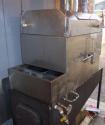
Neat idea! Is the volume of sap being sprayed too high to use cooler sap? Like, what if you used 180 degree sap coming from a pre-heater? Would there be too much volume, and it would kill the boil and/or lower the sugar percent in the syrup pan?
Gabe
2016: Homemade arch from old wood stove; 2 steam tray pans; 6 taps; 1.1 gal
2017: Same setup. 15 taps; 4.5 gal
2018: Same setup. Limited time. 12 taps and short season; 2.2 gal
2019: Very limited time. 7 taps and a short season; 1.8 gals
2020: New Mason 2x3 XL halfway through season; 9 taps 2 gals
2021: Same 2x3, 18 taps, 4.5 gals
2022: 23 taps, 5.9 gals
2023: 23 taps. Added AUF, 13.2 gals
2024: 17 taps, 5.3 gals
All on buckets














 Reply With Quote
Reply With Quote


